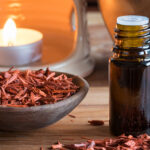Scientific investigation validates sandalwood’s potent anticancer properties
 (NaturalHealth365) Sandalwood has long been known for its anti-cancer effects, especially when it comes to breast cancer. But the exact means through which this potent essential oil affects cancer cells has remained a mystery.
(NaturalHealth365) Sandalwood has long been known for its anti-cancer effects, especially when it comes to breast cancer. But the exact means through which this potent essential oil affects cancer cells has remained a mystery.
Belonging to the Santalum genus within the Santalaceae family, this essential oil-rich plant thrives across regions like India, Australia, Hawaii, and Indonesia. Laden with vital compounds such as essential oil components (α-santalol, β-santalol), phenolic compounds, and fatty acids, sandalwood boasts a wealth of bioactive agents. Recent research confirmed these compounds play a pivotal role in various biological activities, spanning from antioxidants and anti-inflammatory effects to antibacterial and even anticancer properties.
Researchers discover why sandalwood can help breast cancer patients
The study referenced above delved into the rich bioactive profile of sandalwood, unveiling its therapeutic potential through a range of in vivo, in vitro, and clinical trials. Essential oil (EO) components, notably α-santalol and β-santalol, emerged as pivotal factors contributing to both the biological activities and the signature aromatic allure of Santalum species.
Traditional uses of sandalwood EO validated its efficacy in improving various ailments, including colds, fever, lung infections, and inflammation. Recent clinical trials have further substantiated its antioxidant, anti-inflammatory, antibacterial, antifungal, antiviral, neuroleptic, antihyperglycemic, antihyperlipidemic, and anticancer properties.
Older study unveils sandalwood’s profound impact on battling breast cancer
The findings of a groundbreaking University of Texas study were published in the 2016 edition of the journal Evidence-Based Complementary and Alternative Medicine and was a joint effort between Ponce Health Sciences University School of Medicine in Puerto Rico and UT- San Antonio. The focus was on α-santalol, one of the main components of the hardwood genus Santalum, i.e. sandalwood.
In laboratory trials at UT-San Antonio, MCF-7 breast cancer cells, as well as non-tumor-producing breast epithelial (MCF-10A) cells, were exposed to commercially obtained, high-purity sandalwood for 24 hours. The results were remarkable.
Three specific proteins have a positive effect on cancer cells
In the published report, the researchers named three proteins in particular – Ku70, Ku80, EPHX1, and 14-3-3 – as producing “single and double strand breaks” in the MCF-7 breast cancer cells. This was the first study to claim that sandalwood has not only “cytotoxic” effects but also “genotoxic” effects as well, and the first to name the specific molecular pathways through which this genotoxicity could be expressed.
In this study, the DNA of the healthy cells was left unharmed.
Although the University of Texas study is considered groundbreaking, it is actually not the first to point to the unique way sandalwood affects cancer. The study dovetails on a previous project that occurred at the University of Oklahoma in 2014, which compared the different ways that sandalwood and frankincense oils affected human bladder cancer cells. The researchers acknowledged that both were potent against cancer in general, but in drastically different ways.
“The effects of frankincense and sandalwood essential oils … involved different mechanisms leading to cancer cell death,” their report states. “While frankincense essential oil elicited selective cancer cell death via … oxidative stress, sandalwood essential oil induced non-selective cell death via DNA damage and cell cycle arrest.”
Sandalwood has long been known as a tool for helping to combat breast cancer
Sandalwood’s effect on hormones is also important for breast cancer healing and prevention since breast cancer risk is associated most with hormonal imbalance, in particular, too much estrogen and/or progesterone. Again, most research in this regard has focused on α-santalol and have pointed to its ability to balance testosterone levels, in particular, in both men and women.
Although more research can be done about the connection between sandalwood and hormones, the woody, aromatic oil of sandalwood has been used for centuries to calm nerves and anxiety conditions, help with both the physical and emotional symptoms of PMS and as an aphrodisiac.
Here are the other ways sandalwood has proven to affect breast cancer:
- It has the ability to create apoptosis in breast cancer cells. Besides affecting DNA, sandalwood can also create tumor shrinkage and stop growth through cell apoptosis and through its general chemo-protective properties. A 2015 study conducted by Wilkes University in Pennsylvania found that α-santalol in sandalwood had the ability to downregulate survivin, a molecular substance that helps cancer cells to survive and thrive.
- It is a powerful antioxidant. Indian sandalwood has been used for centuries in that country for its antioxidant anti-aging properties, mostly through application on the face and other external skin surfaces. A 1997 report proved its chemo-protective efficiency against skin cancer.
- It is a proven anti-inflammatory. A 2014 Canadian study found that α-santalol helped to decrease cytokines in the body in a similar way to NSAID medications, minus the side effects of these pharmaceuticals. High levels of circulating cytokines can indicate inflammatory responses that can lead to cancer.
Beware of counterfeit sandalwood
Sandalwood essential oil comes from the heartwood of trees of the Santalum genus. These include Indian sandalwood (Santalum album), considered the most potent, and Australian sandalwood (Santalum spicatum). Varieties are also found in Hawaii and French Polynesia, although they are considered of slightly lower quality.
Keep in mind that Indian sandalwood is rare – since most of the older trees with the densest heartwood have already been cut down.
Because of this, Indian sandalwood oil is also the most expensive essential oil on the market today. Beware of counterfeits and dilutions – make sure that you buy from a quality source you can trust. Some efforts for sustainable foresting of sandalwood trees are currently occurring in Australia, but because these trees are still fairly young, the oils gathered from them are not as potent as those gathered from Indian sandalwood trees.
Sources for this article include:
NIH.gov
Degruyter.com
NIH.gov
BreastCancerConqueror.com
Hindawi.com
NIH.gov
NIH.gov
NIH.gov
NIH.gov
NIH.gov



